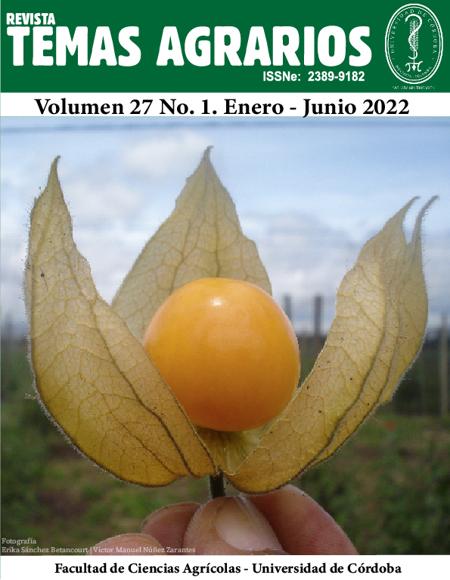Breeding of the herbifagic insect Tarachidia candefacta Hubn. on an artificial nutrient medium to suppress the development of Ambrosia artemisiifolia L plants
Cría del insecto herbífago Tarachidia candefacta Hubn. en un medio nutritivo artificial para suprimir el desarrollo de las plantas de Ambrosia artemisiifolia L

This work is licensed under a Creative Commons Attribution-NonCommercial 4.0 International License.
Show authors biography
Ragweed (Ambrosia artemisiifolia L.) is an invasive plant species from the American continent, which has actively penetrated plant communities, displacing local species of cultivated and weed vegetation. The uncontrolled development and widespread distribution of ragweed in the South of Russia are associated with the absence of natural enemies of this weed. Ragweed is not only a competitor of cultivated and weed plants but also causes allergic diseases. The ragweed moth (Tarachidia candefacta Hbn.) was imported from Canada as a biological agent to control ragweed's development and distribution. We used the mass release of herbiphage into agrocenoses during the emergence of ragweed, which implies an artificial shift in the phenophase of the bioagent, which was achieved by early mass dilution on an artificial nutrient medium (ANM) under laboratory conditions. To cultivate the ragweed moth, the ANM was improved by adding powdered milk as a source of protein and vitamins to the composition, which made it possible to improve the quality of the environment and improve the biological indicators of the development of the bioagent. Replacement of wheat germ with soybean meal in ANM made it possible to obtain a feed balanced in protein and amino acid composition for growing herbiphage. As a result of the research, a method of colonization of the ragweed moth was developed, based on the early mass cultivation of herbiphage on an improved formulation of ANM and the release of T. candefacta at the beginning of the growing season of the weed, which allowed to suppress its growth by half.
Article visits 325 | PDF visits
Downloads
- Agasyeva, I.S., Fedorenko, E.V., Ismailov, V. Y. and Ermolenko S.A. 2017. Method for the production of a nutrient medium for breeding the ragweed moth Tarachidia candefacta Hubn. Patent of Russia No. 2628793, Bull. No. 24.
- Agnew, M., Banic, I., Lake, I.R., Goodess, C., Grossi, C.M., Jones, N.R., Plavec, D., Epstein, M. and Turkalj, M. 2018. Modifiable Risk Factors for Common Ragweed (Ambrosia artemisiifolia) Allergy and Disease in Children: A Case-Control Study. International Journal of Environmental Research and Public Health 7: 1339. https://doi.org/10.3390/ijerph15071339
- Barnes, E.R., Knezevic, S.Z., Sikkema, P.H., Lindquist, J.L., Jhala, A.J. 2017. Control of Glyphosate-Resistant Common Ragweed (Ambrosia artemisiifolia L.) in Glufosinate-Resistant Soybean [Glycine max (L.) Merr]. Frontiers in Plant Science 8: 1455. https://doi.org/10.3389/fpls.2017.01455
- Basse, I.J. and Crompton, C.W. 1975. The biology of Canadian weeds Ambrosia artemisiifolia L. and A. psilostachya DC. Crompton Canadian Journal of Plant Science 55: 463–476.
- Baysinger, J.A. and Sims, B.D. 1991. Giant ragweed (Ambrosia trifida L.) interference in soybeans (Glycine max), Weed Science 3: 358–362
- Bonini, M., Šikoparij, B., Skjøt, C.A., Cislaghi, G., Colombo, P., Testoni, C. and Smith M. 2018. Ambrosia pollen source inventory for Italy: a multi-purpose tool to assess the impact of the ragweed leaf beetle (Ophraella communa LeSage) on populations of its host plant. International Journal of Biometeorology 4: 597-608. doi: 10.1007/s00484-017-1469-z
- Chen, K.W., Marusciac, L., Tamas, P.T., Valenta R. and Panaitescu, C. 2018. Ragweed Pollen Allergy: Burden, Characteristics, and Management of an Imported Allergen Source in Europe. International Archives of Allergy and Immunology 176: 163-180. https://link.springer.com/article/10.1007/s00484-017-1469-z
- Esipenko, L.P. 2016. An adventive weed of American origin Ambrosia artemisiifolia L. as a source of allergy in the South of Russia and promising methods for its suppression, Proceedings of the Kuban Agrarian University 58: 112-120.
- Fukano, Y. and Yahara T. 2012. Changes in defense of an alien plant Ambrosia artemisiifolia before and after the invasion of a native specialist enemy Ophraella communa. Public Library of Science One 7: 11. https://doi.org/10.1371/journal.pone.0049114
- Gentili, R., Asero, R., Caronni, S., Guarino, M., Montagnani, C., Mistrello, G. and Citterio, S. 2019. Ambrosia artemisiifolia L. temperature-responsive traits influencing the prevalence and severity of pollinosis: a study in controlled conditions. BMC Plant Biology 1: 155. https://bmcplantbiol.biomedcentral.com/articles/10.1186/s12870-019-1762-6
- Goeden, R.D., Palmer, W.A. and Scott R.R. 1995. Lessons learned from studies of the insects associated with Ambrosiinae. In North America in relation to the biological control of weedy members of this group, International Symposium on Biological Control of Weeds - Canterbury, New Zealand. pp. 565-573.
- Harrison, S., Regnier, E., Schmoll, J., and Webb, J. 2001. Competition and fecundity of giant ragweed in corn. Weed Science 2: 224-229.
- Kovale, O. V. and Samus, V.I. 1972. Biology of the moth Tarachidia candefacta Hubn and the prospects for controlling ragweed, Agricultural biology 2: 281-284.
- Kovalev, O.V. 1981 Introduction and acclimatization of ragweed phytophages (Ambrosia L., Asteraceae) in the USSR, Aspects of general entomology 63: 31-32.
- Kovalev, O.V. and Runeva, T.D. 1970. Tarachidia candefacta Hubn. (Noctuidae, Lepidoptera) moth is a promising phytophage in biological control of Ambrosia L (Compositae) weeds. Entomological Review 49: 26-36.
- Lake, I.R., Jones, N.R., Agnew, M., Goodess, C.M., Giorgi, F., Hamaoui-Laguel, L., Semenov, M.A., Solmon, F., Storkey, J., Vautard, R. and Epstein, M.M. 2017. Climate Change and Future Pollen Allergy in Europe. Environment Health Perspect. 3: 385-391. https://doi.org/10.1289/EHP173
- Matishov, G.G. 2011. Biological methods of controlling ragweed in anthropogenic phytocenoses of the south of Russia. pp. 139
- Moskalenko, G.P. 2001. Quarantine weeds of Russia. M.: Rosgoskarantin, pp. 280
- Nagy, E., Hegedűs, G., Taller, J., Kutasy, B. and Virág, E. 2017. Illumina sequencing of the chloroplast genome of common ragweed (Ambrosia artemisiifolia L.). Data Brief. https://doi.org/10.1016/j.dib.2017.10.009
- Scalone, R., Lemke, A., Štefanić, E., Kolseth, A.K., Rašić, S. and Andersson, L. 2016. Phenological Variation in Ambrosia artemisiifolia L. Facilitates Near Future Establishment at Northern Latitudes, Public Library of Science One 11. https://doi.org/10.1371/journal.pone.0166510
- Smith, M., Cecchi, L., Skjøth, C.A., Karrer, G. and Šikoparija, B. 2013. Common ragweed: a threat to environmental health in Europe. Environment International 61: 115-26. https://doi.org/10.1016/j.envint.2013.08.005




















